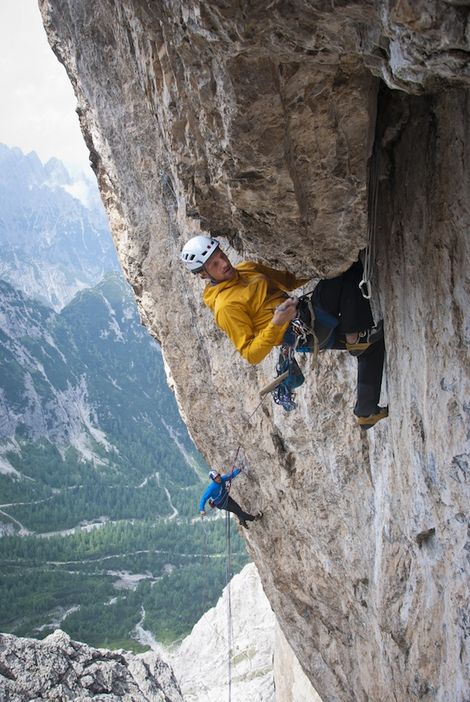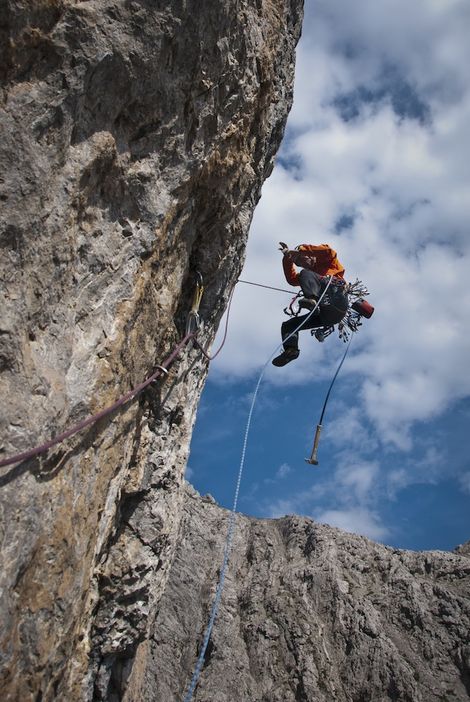Safety Discussion – All but “too easy”.
July 2012: Peter and I have been hanging in this grey-yellow sea of limestone for hours, 200 meters above the start of our route. Progress is slow - extremely slow. Every couple minutes I try to get higher up, but after three or four meters, I stop, can't find the next hold, and gravity does its work.
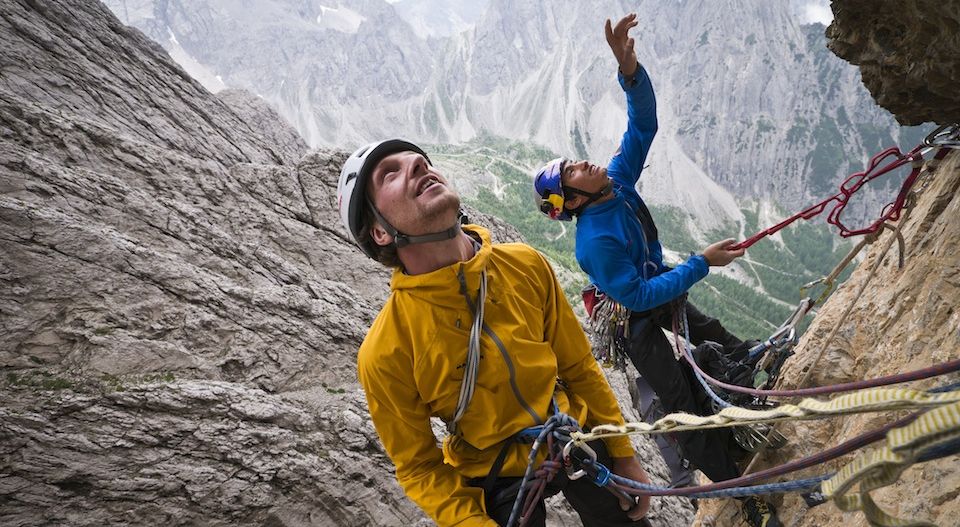
Discussing the next pitch.
How easy would it be to get the drill out, and drill straight up the blank, slightly overhanging wall. But at the same time, I wonder, would the appeal of the whole endeavor still be the same?
We stood under this wall for the first time a little more than a month ago. Together with Peter, I wanted to free the Jugendführe, but as we stood at the start of the route, and our eyes followed the line we intended to climb, our thoughts drifted away, towards the right to an enormous flake, then straight through huge roofs, and at the end through the slightly overhanging, grey-yellow headwall of the south face of Laserz.
We climbed the Jugendführe right away, and were back under the wall the next day. This time, it felt different - we had not come to repeat an existing route, but to create our own line. More important: We had a very precise idea of what this line should look like. With two sets of cams, stoppers, pins, and a bit of aid climbing regalia we set off into new terrain.
Progress was slow. We had to fight for every meter. Again and again we fell and had to muster our courage once more to climb far above our gear. Single moves took minutes, entire pitches were a matter of hours, and it quickly dawned to us that we were in for an adventure that we would not be able to end that day.
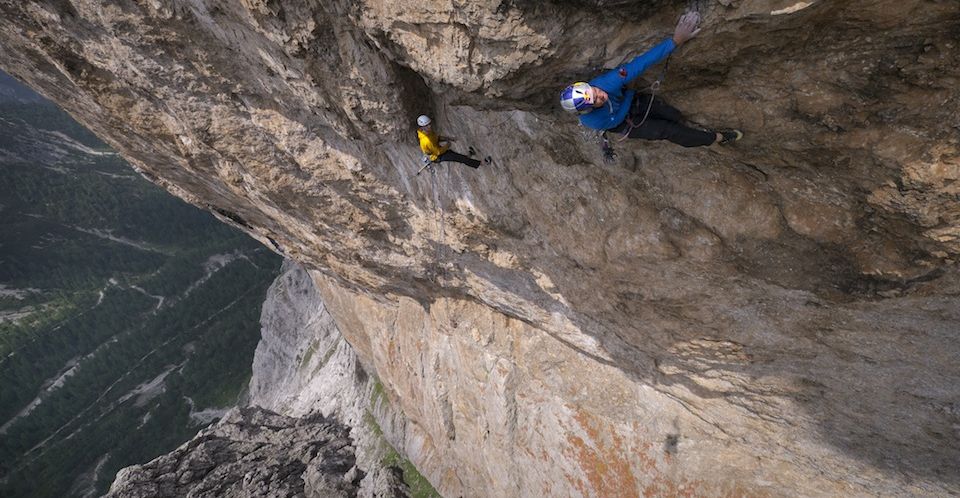
David on the third pitch of the route.
We had no interest in finishing the route as quickly as possible anyway. We wanted to do this first ascent in the best style possible and with minimal use of bolts. That takes time, we said to ourselves, after all we are "carving" our ideals into this rock face right now.
I try again, climb away from my gear, and work my way up hold after hold. A thin crack takes a pin. I don't really trust it much, it would never hold fall, but maybe it's body-weight and I can aid through the next couple of moves. I place a hook into a small pocket and give it a tap with the hammer. I don't really trust it, but it's the most reliable pro in the last five meters. I'm hanging on the hook and rest a bit. Again, I am thinking about the drill - how easy would it be to place a bolt here? But I know the answer, too easy! I continue upwards, can't place gear, and the pump builds with every crimp.
After another seven meters, I can finally set up the saving anchor and while I belay Peter up, I glance upwards and realize that we will get it done today. Another hundred meters of easy terrain and we will stand on the summit.
September 2012: About a month after our expedition to the Karakoram, Peter and I return to our route to make a continuous free ascent. Fall has arrived, the larches' leaves have turned yellow, the ground is frozen, and the conditions for climbing are almost perfect.
In the first four pitches, I have to realize that my forearms aren't what they were in early summer. With frozen fingers, I fight through the fifth pitch, which leads straight through the big roof - the hardest pitch is done. Peter climbs the first part of the headwall, and keeps cool as well. The next two pitches of 10- (8a+) are mine to lead. Everything is at the limit, but I stay calm despite the sparse protection and don't fall.
To me, the route Safety Discussion is one of my most beautiful first ascents, and it's especially valuable because of the minimal use of bolts. The route is long, demanding, and while the next potential suitors won't have to climb into the unknown, the first time on the route will remain an adventure for sure. All the anchors have at least one bolt, but there are only six more bolts on the entire route for protection. Safety Discussion leaves the Jugendführe after the first pitch and heads right; we estimate the difficulties to be (7b+, 7b+, 7c+, 7a+, 8b, 7c+, 8a, 8a+, 5, 6). Take two sets of cams (to #5) a good set of stoppers and pins, and a few hooks for a repeat.
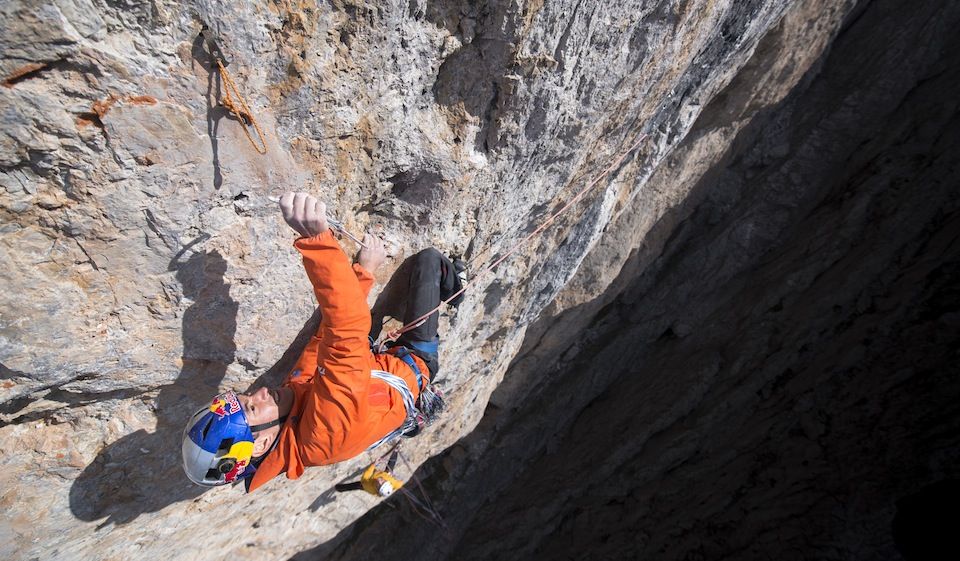
Interesting protection in the headwall.
